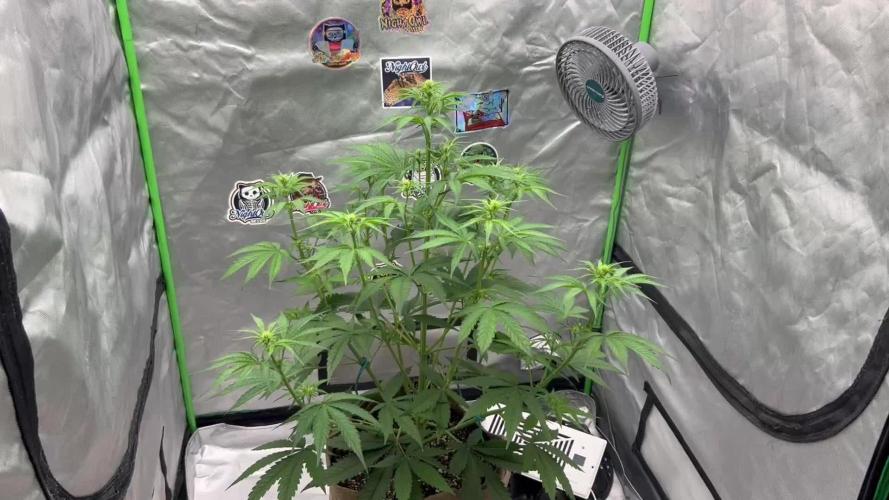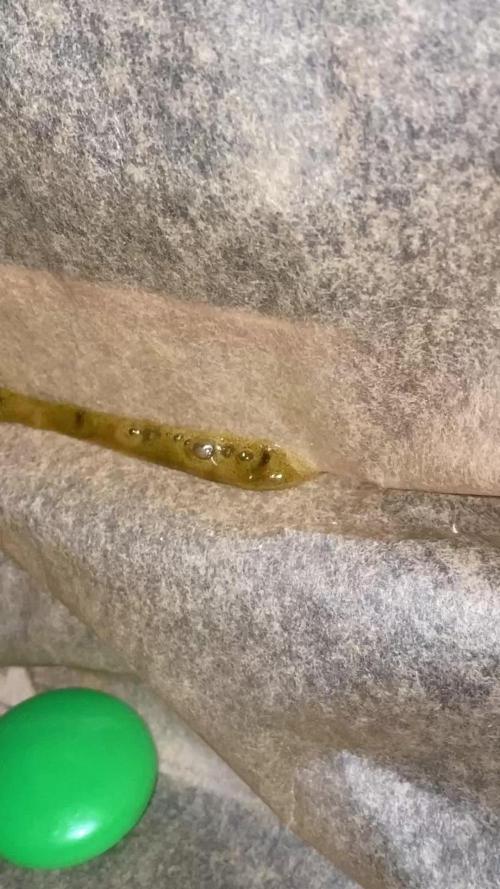The Grow Awards 2026 🏆 































Likes
Comments
Share


@danwho
Follow
Harvest day 11/3/23 - day 56
Sent about 2lbs of trim, larf, and sugar leaves to vacuum seal and the freezer for bubble hash later. Unsure of the weight of the buds hanging, but I can say it is more than I expected that is for sure! Excited to get a weight here in 5-6 days before trimming and jarring.
I ended up having to cut the plant down in smaller pieces due to the trellis netting. Also due to the fact I planned to utilize the tent for drying, I needed to be able to completely remove the DWC setup and adjust the ventilation and net to use as hanging.
11/11
Final result picture:
1 jar of sugar trim - for RSO or bubble
1 jar of stems - for RSO or bubble
L (lower quality bud jars) 0.75oz, 0.75oz, 0.65oz = total 2.15oz
M (middle-quality bud jar) 0.9oz, 0.65oz = 1.55oz
T (top quality bud jar) 0.75oz = 0.75oz
TT (super top quality bud jar) 0.75oz, 0.45oz = 1.2oz
total dried and curing in jars: 5.65 ounces
about 2lbs of frozen plant material for bubble hash
1 full jar of sugar trim for bubble or rso
1 full jar of stems for bubble or rso
11/29 update
Made just under 6 grams of bubble hash from the trim and larf (one wash). Recooked the single wash trim and larf into butter with additional sugar trim added. Made about 1lb of butter - dosing unsure, but potent :D
Likes
8
Share


@XYZ123
Follow
So my plants grow very fast I am. I bought Nutrients from Biobizz. We are looking forward to the next week
5 days fish mix and biobizz grow
2 days biobizz grow, biobizz heven, ph -, biobizz ACTI-VERA,
Likes
66
Share


@Neo09
Follow
Since 18.6.➡️12/12
⚠️I love thoose clones, the
are really fit and strong⚠️
Bluebery pancake's became ADVANCED NUTRIENTS - Sensi Bloom, BigBud, Budcandy and Nirvana
Likes
18
Share


@Dunk_Junk
Follow
Doubled her height this week.... from 3cm to 6cm 😂 but she pushed out a fair few leaves into the process.
Going well so far.
Likes
57
Share


@nonick123
Follow
Día 13 (06/05) Nos acercamos al final de la fase plántula. A ver si ahora empiezan a crecer de forma explosiva!
He sido muy estricto con los riegos, dejando que el top hasta el nudillo se seque completamente!
Día 14 (07/05) Hago una mejora en la tienda. Hasta ahora tenia intracción pasiva, pero ahora he instalado una turbina para que impulse aire fresco dentro de la tienda
Día 15 (08/05) Con el calor que hace me sorprende que las macetas sigan aguantando la humedad, pero al hundir el nudillo sigue húmeda. Mañana haré un riego de nuevo
Día 16 (09/05) Relleno el top con sustrato para compensar la compactación y dar mas soporte a las plantas
Riego con 300 ml solo H20 - pH 6,2
Día 17 (10/05) Baño de sol de dos horas.
Día 18 (11/05) Baño de sol de dos horas
Día 19 (12/05) Riego 750 ml H2O + Regulator 0,15 ml/l + CaMg-Boost 0,25 ml/l + Startbooster 0,25 ml/l - pH 6.2
💦Nutrients by Aptus Holland - www.aptus-holland.com
🌱Substrate PRO-MIX HP BACILLUS + MYCORRHIZAE - www.pthorticulture.com/en/products/pro-mix-hp-biostimulant-plus-mycorrhizae
Likes
5
Share


@sanibelisl
Follow
Mulberry Day 35
All is well. In stretch and transition to flower. She is a proud 28 inches tall. I tied her four bottom branches down to open her up some and get better airflow and light penetration. As an experiment I have only been removing the newly formed branches at her nodes and leaving the fan leaves alone. Seems to have an effect on branches being healthier!
*** watered her last night with 1 tbsp each of coco bloom A&B.
Likes
7
Share


@eldruida_lamota
Follow
Esa familia, e retrasadonun poco la floración de estas gelato para que las Purple alcanzasen la altura y el ritmo.
Todo va de perlas practique varias apicales para retrasar el crecimiento para arriba.
Se ven bastante sanas y están pillando un tallo goloso. No tiene nada que ver con el anterior proyecto, este si tiene pintaza.
Agrobeta:
https://www.agrobeta.com/agrobetatiendaonline/36-abonos-canamo
Mars hydro:
Code discount: EL420
https://www.mars-hydro.com/
Bueno las maximas de temperatura no superan los 25 grados y las mínimas no bajan 19, así que no me puedo quejar.
Los niveles de humedad también son los correctos van entre 50%/65% de humedad relativa.
Por supuesto el Ph lo estamos dejando alrededor de 6.
Hasta aquí es todo poco más la verdad ya con ganas de empezar la floración, buenos humos 💨💨💨
Likes
20
Share


@Grow_Outside
Follow
THE FINAL STEP🍯
Nach 6 Tagen der Trocknung hab ich das Bubblehash weiter verarbeitet☘️
Dafür hab ich eine Grasspresso V2 mit 2 Tonnen benutzt die Super easy zu bedienen ist 😅
Ein 35mikron Bag von Graveda war ebenfalls von Nöten! Gefüllt hab ich das Bag mit 2g vom Hash und unter die Presse gelegt, gepresst hab ich mit 85 Grad und den Timer auf 300 Sekunden
Die ersten 30 Sekunden hab ich nur mit den Platten das Material erwärmt und dann langsam angefangen zu pressen, ca alle 20 Sekunden wurde der Druck erhöht und ja was soll ich sagen :)
Seht selbst 🍯☘️🍀💚
Likes
5
Share


@AustinRon
Follow
TH 1Q2025 - Week 8 - Flower 5
(ON Haze X Original Haze) X Northern Lights #2
“Todd’s Haze”
Objective
- 8 Female Plants, Topped ONCE @ Flip, 12” when topped
- Modified Sea of Green
Seeds Wet: 1139PM, 28.2.2025
Germinated: 2.3.2025
Flip: 21.3.2025
Harvest: 77 Days, DATE: 6.6.2025
_________________________________________
__
Fri Apr 25, 2025
TH 1Q25 36:F:5:1
Cleaned Emitters - Replaced Pump
Cleaned Manifold Filter = TWICE
Replaced IRRIGATION Pump with mini-sump
Photosynthesis plus produces enough biofilm to disqualify from running in the reservoir.
- Remediate: Apply half diluted to watering zone, every other day. Include PCAL 1660 for Add’l Calcium and Phosphorous
- [x] CEASED PHOTOSYNTHESIS PLUS IN RESERVOIR
- The BIO film is ‘orange/pink,’ PSP is the SUSPECT.
- [x] Harvest Dehu
- [x] Refresh Reservoir - 2 Gallons
- [x] EC: 2.3, 2.4
- [x] Primer A & B: [ 31, ml]
- [x] Silica Skin GEN 3: [ 16, ml]
- [x] SLF-100: [ 10, ml]
- [x] 1900: Measure Runoff
- [x] Amount: [ 1250 , ml]
- [x] EC: [ 2.3, mS/cm]
__
Sat Apr 26, 2025
TH 1Q25 37:F:5:2
- [x] Replace Main Feed (1/2 Silcone tubing) with 3/8” Black Chemical Resistant
- [x] Refresh Reservoir - 2 Gallons
- [x] EC: 2.3, 2.4
- [x] Primer A & B: [ 31, ml]
- [x] Silica Skin GEN 3: [ 16, ml]
- [x] SLF-100: [ 10, ml]
- [x] 1900: Measure Runoff
- [x] Amount: [ 950, ml]
- [x] EC: [ 2.4, mS/cm]
__
Sun Apr 27, 2025
TH 1Q25 38:F:5:3
- [x] Lower Defoliation in Preparation for Intra-Canopy Lighting Install
- [x] Harvest Dehu: 3.5 Gallons (None Yesterday)
- [x] Refresh Reservoir - 3 Gallons
- [x] EC: 2.4
- [x] Primer A & B: [ 48.8, ml]
- [x] Silica Skin GEN 3: [ 24.4, ml]
- [x] SLF-100: [ 15, ml]
RUNOFF: [ 950, ml, 2.4/5, mS/cm]

__
Mon Apr 28, 2025
TH 1Q25 39:F:5:4
Observations
- @ 2.4 EC is making for DENSE GREEN in the leaves. We DON’T lack nitrogen. ;-}
- Some Nitrogen Curling on NL2 Dominant (Pheno #2) - Will REDUCE EC if doesn’t abate today . . .
- We have some White filmy scum forming on top surface of res water. Suspect Silica. Will clean out res TUESDAY and restart w/Out Silica Skin. If we’re clear FRIDAY - Start Re-adding until and unless white scum forms …
Reducing EC: 2.3 # Will reduce Day by Day to 2.1
- [x] Harvest Dehu: 2.5 Gallons
Runoff
- [x] EC: [ TBD, mS/cm]
- [x] Amt: [ 950, ml]
__
Tue Apr 29, 2025
TH 1Q25 40:F:5:5
- [x] Install Intra-canopy Light 50% Dimmer
Note: After H2O2 yesterday, and 1 cup (in about 2 gals) today - the amount of scum is REDUCED SIGNIFICANTLY. I filtered with hand strainer until there was no more film or particularate (there wasn’t a lot) - The overall appearance is better.
Have refreshed with 3 Gallons and Primer A&B Only (and SLF-100). We’ll monitor. If it stays clean, we’ll test again with Silica Skin Gen 3.
__
Wed Apr 30, 2025
TH 1Q25 41:F:5:6

Refresh Reservoir
- [x] Amount: [ 2, Gal]
- [x] Primer A&B: [ 32, ml]
- [x] SLF-100: [ 10, ml]
Runoff
Amount: [ 2, gal]
EC: [ 2.9, mS/cm]
R&R Reservoir (Rinse components w/ 45% H2O2)
- [x] Disconnect MAIN FEED Line
- [x] Disconnect, Remove, and Clean PUMPS
- [x] Flush Chiller
- [x] Clean Reservoir
Reassembly
- [x] Reinstall components
NOTE: We have a SMALL amt of white slate like precipitate - Most Likely Silica …
__
Thu May 1, 2025
TH 1Q25 42:F:5:7
Mix 1 Liter of CalPhos for HAND APPLICATION Tonight
CAL50K, 1 ml yields .5 EC (250 ppm)/Liter, or .125 EC per Gal
~16 ml’s/gal - ~2.1 EC
- [ ] Mix and ApplyPCAL 1660 & CAL50K
- [ ] Photosynthesis Plus
- [ ] Quillaja 60
- [ ] Apply ~ 120 ml/plant
- [x] CAL50K to EC: 2.1 (4 ml/qt)
- [x] For 2.1 EC: [ 16, g] Cal50K
*** RESERVOIR EMPTY!!! ***
After REDUCING Per Event flow in Half - we STILL Emptied the reservoir …
SINCE we ONLY HAD 2 GALLONS, We’re good (Catchment is 2 Gal)
Last night I cleaned the manifold filter ~ 7PM (Start Time) and reduced to 18 minutes TOTAL time (9 Events, 2 minutes/event)
Runoff
Amount: [ 7600, ml] # We Emptied the Res Overnight, at 3 min/event - dropped to TWO ~2300
EC: 2.9
Refresh Reservoir: 2 Gal (Reclaimed DEHU)
- [x] SLF-100: [ 10, ml]
- [x] Primer A&B: [ 32, ml]
Likes
60
Share


@Cannibalgardens
Follow
This was an overall amazing strain to grow i had little to no problems with this plant. The ease of growing it was great because as being a newby to growing weed for personel use that was super helpfull. I liked how the smell was strong from day one and just how she grew so fast . i would recommend this strain to anyone because it smells great piney , citrus, earthy sticky . Dinafem did a great job of making my life super easy when it came to growing it . As long as i can get a priper cure on this bud it will be amazing smoke for sure.. I hope anyone who sees the journal enjoys it and ill be doing more in the future i love this forum and the other amazing growers out there ..it says 8 weeks its been hard maintaining entries at first and timely so she is over 8 weeks flowering when i chopped it..smoked some of the plant that was chopped up alittle while before this girl tastes very good and the stickiness of the buds is very impressive i would like to enjoy this plant and grow her again some time ...
Likes
7
Share


@Drtomb
Follow
2 weeks left on the flush. Running water with addrd Hydro Bio. Ive been noticing very nice white root growth on my vegging area... And lots of it. Hoping these look good. But they were 3 or 4 weeks on the previous bleach sterilization test. Gorrilla. Glue #4, my next grow has been on it since day one. So subscribe to that grow.
Likes
2
Share


@SpartacaZ
Follow
L unica che mi piace sto giro sono la gorilla e la runtz....le piramidi non piacciono...
Likes
25
Share


@Gutismoke102
Follow
Wow look at her grow we are in the second week of her flowering stretch and she looks amazing. Smells good already omg super excited about this one ☝️🏽
Likes
14
Share


@Dernert420
Follow
Somit beginnt Woche 5.
Woche 4 war entspannt. Abermals legt Painkiller XL ein gutes Wachstum hin. Ich schätze, dass der Stretch nun vorbei ist und alles in die Blüten geht.
Schaut euch dieses Blüten bitte an. Wunderschön und harzig.
Likes
21
Share


@Bluemels
Follow
Nun, die vergangene Woche ist nicht so gut gelaufen....😞
Ich bin regelrecht in ein Schnippel-wahn verfallen...😱
Dann wollte ich ein Fehler mit dem nächsten ausgleichen, das Ende vom Lied kann man deutlich sehen.
Da wollte ich gleich alles richtig machen doch die Pflanze wurde dabei immer weniger.😭
Das dauert bis die Gute sich davon erholt...
Gestern habe ich über die verstümmelt Triebe noch Tütchen gefrimelt, um die Luftfeuchtigkeit um die Triebe herum zu erhöhen.
Und es hat zum Erfolg geführt! Sie haben sich deutlich innerhalb eines Tages deutlich gestreckt!😃
Allerdings muss ich alles gut im Auge behalten damit es in den Tütchen nicht zu feucht wird, deswegen habe ich heute je ein kleines Belüftungsloch in die Tütchen geschnitten.
Likes
25
Share


@The_Lonely_Farmer
Follow
So these girls have pushed through and look at thos dark purples coming through 😍
Only ph water has been fed this 9th/10th week and all trichomes cloudy with the odd amber showing through 🌱
Looking beautifull and love the colours, the smell is unreal so fruity 🔥
I may harvest over the next 3 days as too get it dried and somewhat an extra cure in mason jars ready for xmas smoke 😍🔥


























